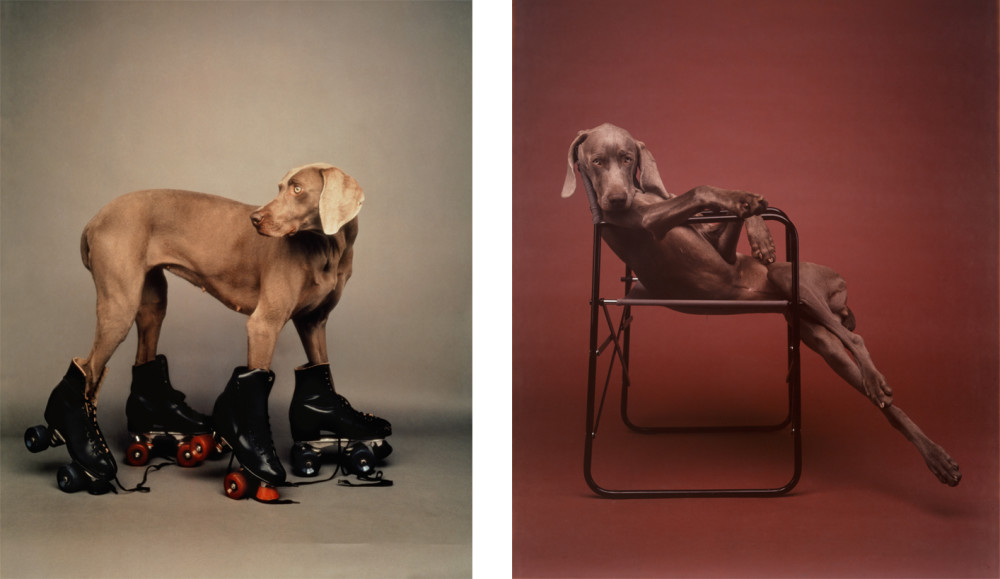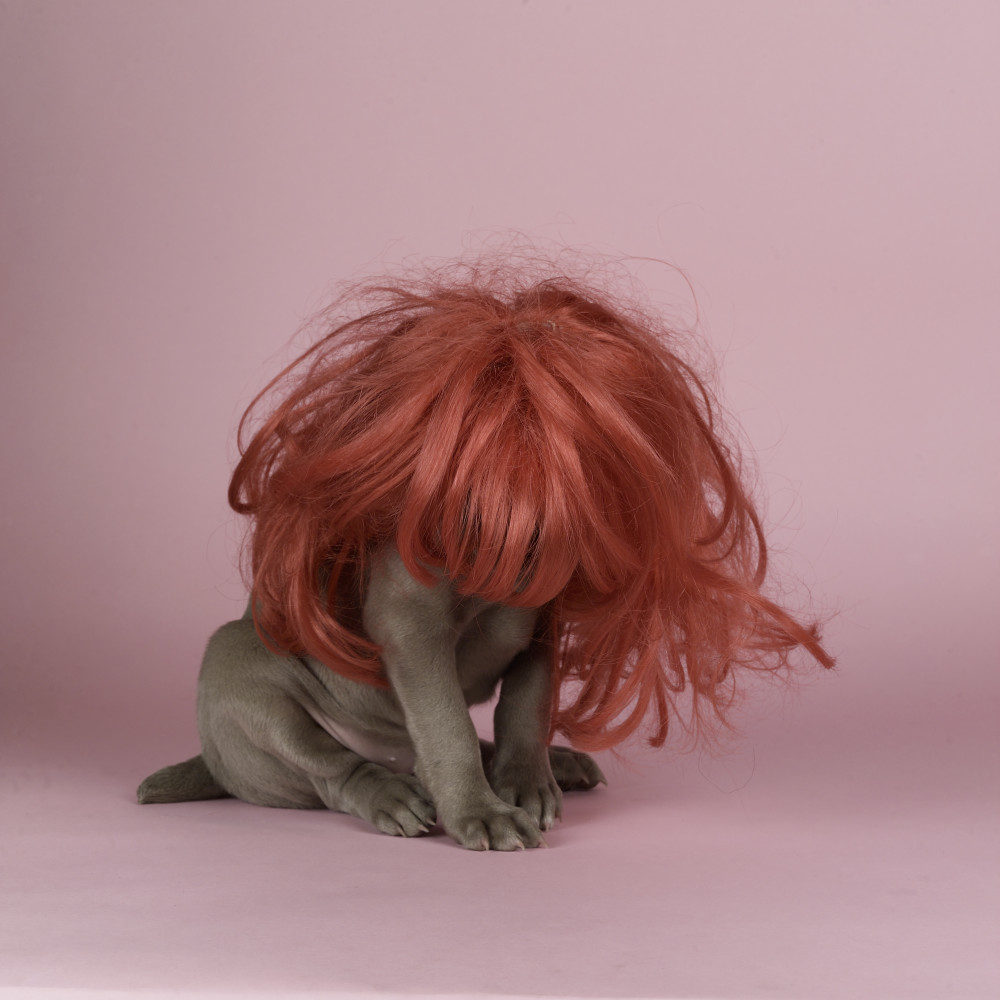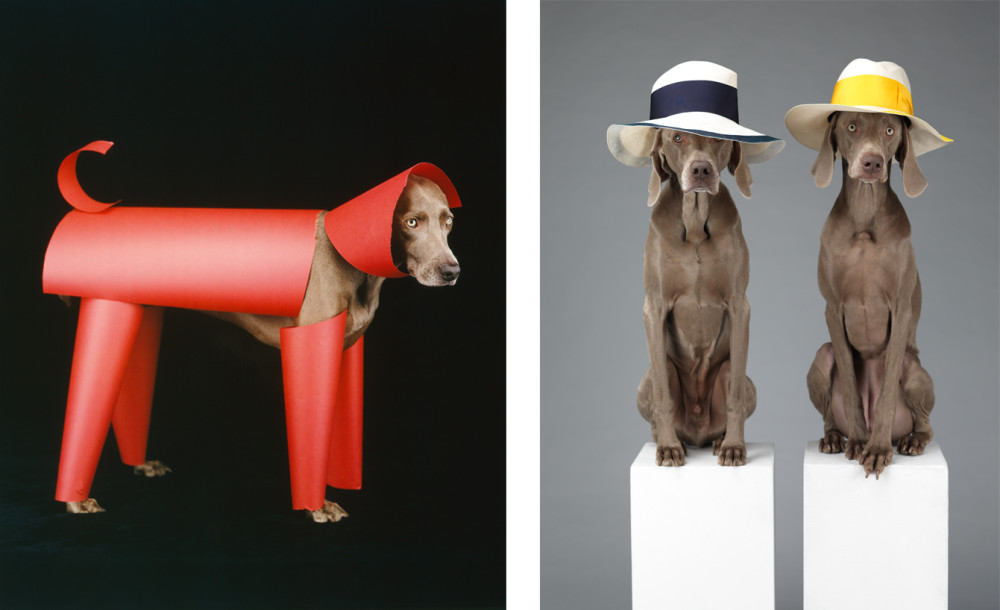Image above: ©Kimberly M. Wang / Eardog
ANDREA BLANCH: Were you a painter or a photographer first?
WILLIAM WEGMAN: I was first a painter, and then after grad school I had grad students teach me how to print and develop at the University of Wisconsin where I was teaching.
AB: Why the foray into photography? Was it just curiosity?
WW: I was doing performance, installation pieces and temporary pieces, and I wanted to document that. First, I would have my friend Robert Cumming doing the photography, but eventually he said, “Get your own camera and do it.” So I did. I thought it was really important to communicate with the rest of the world, and photography and video was a way to do that. Painting just seemed reproduced; it wasn’t the same.
AB: What year was this? WW: In the late ‘60’s. I came out of grad school in ‘67 when painting was being challenged anyway, so I went that route.
AB: What do you mean when you say you were thinking more about the picture?
WW: I remember floating things down the Milwaukee River, then getting up on a bridge and photo- graphing them. I realized that I was positioning myself to make it look a certain way. I think I also wanted to communicate with people other than just fellow students or other people who happened to be there.
AB: Have you always gone back and forth?
WW: I renounced painting until the mid ‘80’s. Then I got nostalgic about it, since I’m a childhood painter. So, I said, “What the hell.” I started to do it secretly in my studio in Maine, without telling anybody. Then my dealer, Holly Solomon, got excited about them, of course, and I started showing them through her.
AB: How did we get to the dogs? WW: My first one was the one I named “Man Ray.” He was kind of spooky and interesting, and wasn’t too doggy. It seemed more serious than just the guy who dresses his dog up.
AB: But how did you get to that?
WW: After I moved to L.A., I got this very young puppy who went to my studio. He was really interested in it, always putting his face in front of the camera or helping me set things up. That’s how that happened. I had just started to get involved in video, and he was amazing, how he looked in those videos.
AB: Did you know right away as you were doing these videos and photographs, that they might be- come the cornerstone of your career?
WW: I knew it was something pretty amazing, but I also knew that it was dangerous, so I avoided using the dog unless it was something really good. I was very suspicious, or afraid of it. I was really extreme in my editing. Each piece is rather special. It isn’t just, “Oh, the dog’s in it,” like a signature. I didn’t really get into the dogs until I started painting, and then it was okay for my photography to just be the dog. I got Man Ray in 1970, he lived until 1982. From 1982 to 1983, I did altered photographs and drawings on things, a friend of mine called it “prison art.” It was a little bleak. Then I got Fay. I wasn’t going to photograph her, I just wanted her as a pet but she was always lying around and look- ing really bored. The people at the Polaroid studio called me and said, “Bill, come on. You’ve got to come back here.” So I brought Fay, and she really loved it. That’s how it started again. These types of dogs like to be busy; they like performing. Fay was about one when she started to work with me. I was really cautious, I didn’t want to repeat the Man Ray period. But what I found is that she was very different: she photographed differently and held the page in a different way. When she had puppies, I had many combinations to work with. That lead to the children’s books, the videos for children on Sesame Street, and so forth.
AB: I just want to clarify something: when you got Man Ray, was that as a pet or to use him as a subject?
WW: Absolutely as a pet. And almost reluctantly. I was afraid to get a pet; I thought it was too much responsibility. My wife persuaded me to get one. It’s a true story that I flipped a coin and it came up tails five time in a row.
AB: I read that you were frustrated to be typecast as a “dog photographer.” WW: Yes. AB: But then as you got more successful, I guess you became less frustrated with it?
WW: No, I really stopped. In 1978, I didn’t use him at all. It was really bleak. I realize now that I enjoy it a lot. I love getting to know them better through photography. Getting to know their looks and interacting with them. Imagine if you’re Karole Armatage and you’re working with dancers: you get to know them, and you really enjoy it. It’s the same with me. It’s this troupe that I have, and things evolve; that’s what I’ve come to really love about it. Now that I’m painting and doing other projects, it doesn’t seem like it’s a one pony thing.
AB: Were you surprised at the popularity of the dog photographs?
WW: No, because I knew it was pretty amazing right off the bat. I knew that I had reached people who weren’t just in the art world as well as the coolest people in the art world. Even Jasper Johns liked my work. I had more of a problem when I started to dress up the dogs and do the children’s books. I did a couple of ads, and then it really got big. I was doing book signings and things like that. There was a lot more press in the early ‘90s. Then it became more confusing, because I got rampant interest from dog people. I think it alienated certain factions in the art world, which is expectable.
AB: Did you find that the popularity of dog photographs was distracting people from your other work or from your versatility as an artist?
WW: I don’t know exactly. I remember walking my dogs and I heard someone say, “I used to love those dogs, until ‘that guy’,” - meaning me; he didn’t know it was me. You realize people get sick of your work if you’re too popular, no matter what you do. It is more about the Karole Armatage thing that I mentioned; it’s the daily interaction with them that is very satisfying. Every once in a while, something comes out that is an evolution that’s interesting, that’s a refinement or a break. I’m still looking forward to that. Each dog brings something to it. Even though it’s another grey Weimaraner, each one brings something different than the past ones.
AB: How long do they sit for?
WW: They don’t have to be up for more than a few seconds, really. Photography is the sixteenth of a second at the slow speed. So you get them up then get them down. The thing is, when I’m photograph- ing one I have to put the other one up too, otherwise they compete and get jealous. So I put them just outside the frame so they’re not being photographed, but they think they are. There’s something about the light and the attention that they like. Working outdoors is interesting, also.
AB: I would imagine working outdoors is more difficult.
WW: Not really. It’s catch and release. You grab them, and then they’re off doing their dog thing, and then they go, “Oh, Bill needs me. Here I am. Then, I’m off again!” I always keep it really fun; I never stress them out. I don’t like the ears back and panting look; that’s not a good look. You can tell when they don’t want to do it.
AB: What are the advantages of working with dogs instead of human models?
WW: Well, the disadvantage is they won’t help you carry stuff. The advantage is you don’t have to pay them; you just have to throw them some bones. They do it for me and they don’t get embar- rassed if they have a funny hat on, even though I might for them, but they’re just sort of proud to be part of it.
 ©William Wegman, (left) Roller Rover; (right) Lolita, 1990. Courtesy of the artist.
©William Wegman, (left) Roller Rover; (right) Lolita, 1990. Courtesy of the artist.
AB: Do you find that having the consistency of a single subject frees you to experiment with technique and composition?
WW: It’s always interesting to have a “muse”, but by that you also have limitations. The thing that inspires you is also the thing that confines you. Imagine if you are someone who does landscape photo- graphs, you might like the desert more than you like the forest, I don’t know. It’s something that makes you concentrate differently.
AB: So if you could do anything, what would it be? WW: I don’t know, it’s too complicated. It’s frightening, right?
AB: You’ve kind of answered this but: is there something about the Weimaraners that lends itself to being photographed?
WW: The fact that they’re pointer retrievers: their stillness, their calmness. In the videos they would bring things back to me. Man Ray would go out of frame and come back in with the thing that I sent him out for. The fact that they’re neutral grey and also reflect color; they’re like mirrors. If they’re out on a bright blue day, they look kind of purply; if they’re indoors in a wooden room, they look tan. They’re very sensitive to the set paper colors.
William Wegman. Bikini, 1999 Color Polaroid 109
AB: What about the eyes?
WW: I love that. They start out with blue eyes, brilliant blue, like ultramarine blue. Then they transition to an amber yellow, typically.
AB: What subjects are you drawn to when you’re not photographing the dogs?
WW: Well, my kids don’t allow me to photograph them anymore. Christine won’t let me photo- graph her. I’ve had girlfriends in the past who’ve liked it. One girl, Hester, loved to pose, so I did some nice pictures with her and Man Ray. One of my assistants, Andrea, is in the pictures with Fay in the mid ‘80s. I started using her hands too, so she would become Fay’s arms, which is what led to these characters.
 ©William Wegman, Hot and Pink, 2004. Courtesy of the artists.
©William Wegman, Hot and Pink, 2004. Courtesy of the artists.
AB: There’s one pose where you got the dog to sit down, with her legs extended. It’s so human. I want to know how you got her to do that?
WW: That’s Batty. That dog was so relaxed, so trusting, so limber and had such a saucy look. That’s my favorite photograph, ever, of a dog.
AB: How do you get a dog to do that? That’s incredible.
WW: Well that was one time, what she did, and that’s the special thing about her. Fay was opposite. That’s why I cast Batty as Cinderella, and Fay as the evil stepmother, because they have those inherent looks. Besides Fay being so different from Man Ray, when I had Batty, I could see that this was really a whole different way of relating.
AB: How long did she live for? WW: 14 years. AB: And so now you have two. WW: Yep, half-brother and sister. Very sculptural. AB: Do you want any more?
WW: No. I never meant to have four. One of my dogs was diagnosed with lung cancer and was sup- posed to live six months at the most, and lived four more years. The other one was similar. They out- lived their life expectancy.
 ©William Wegman, (left) Red Toy, 2006; (right) Hat Dogs, 2013. Courtesy of the artists.
©William Wegman, (left) Red Toy, 2006; (right) Hat Dogs, 2013. Courtesy of the artists.
AB: Generally, you don’t paint your dogs. Why the separation?
WW: It’s really set in my mind that I’m not going to be doing that. I will doodle them occasionally or I write books that involve them for children. Photographically, I’m just not interested in anything now except the dogs. Like we talked about before, there are just too many things that you could do, and I like concentrating as long as I have these subjects that are willing and beautiful.
AB: What’s next?
WW: Some of the painting wound up in a book that Abrams is publishing. We have writers involved in that so it’s going to be partly literature, and then these pictures. I’m going out next week to Illinois to be in a show that has all my work in it: art references, drawings and paintings.
AB: Why did you start going into children’s books?
WW: Someone asked me, and I thought it would be good. So I did Cinderella first, then Little Red Riding Hood, and they were interesting. I got a contract later with Hyperion and now with Penguin, which owns Dial for children, so I’m continuing to do that.

